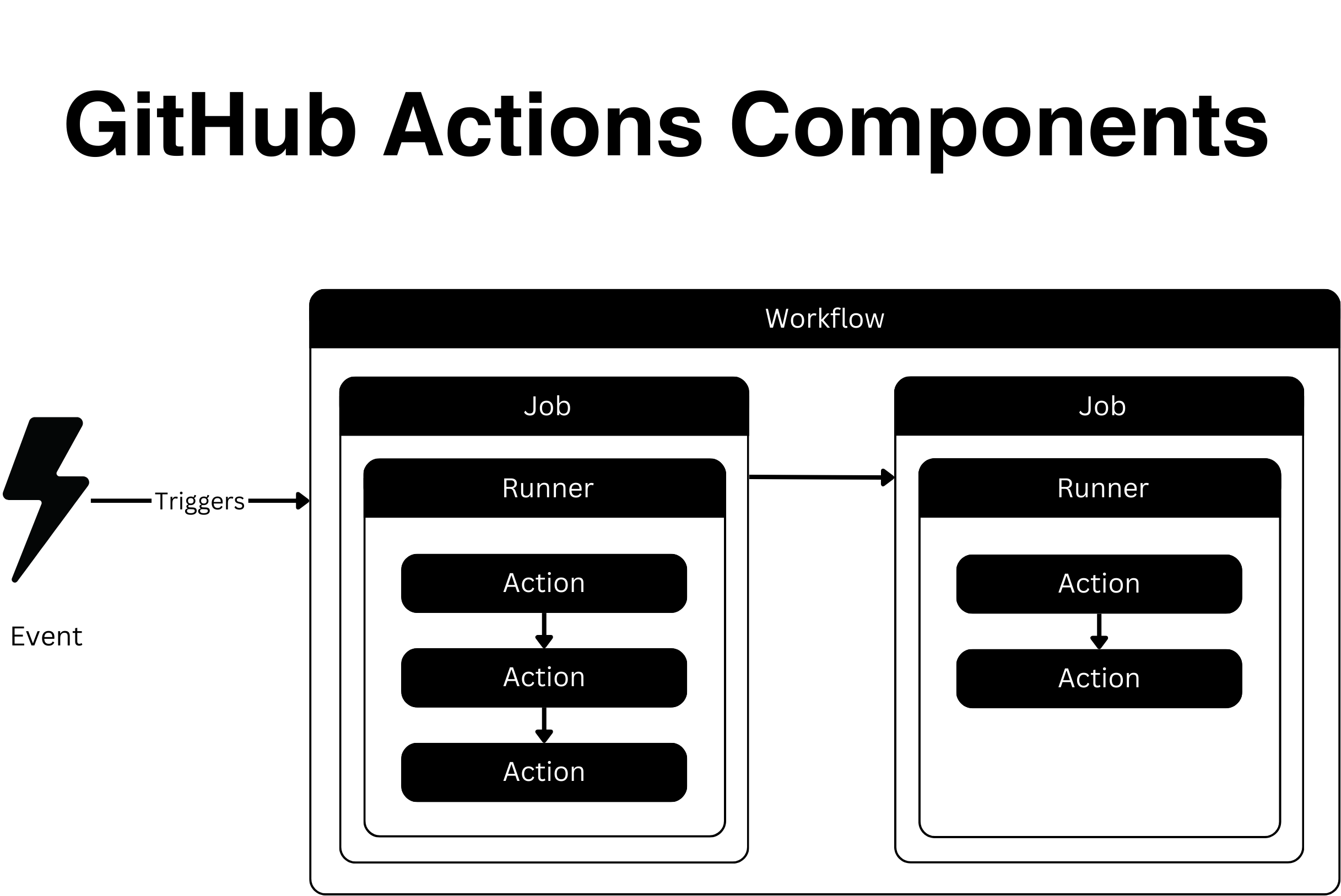GitHub Actions is a powerful platform built into GitHub that lets you create and run various code automations. These automations can help streamline repetitive or complex tasks, such as testing new changes, deploying releases, and running static code analyzers to detect bugs in code.
GitHub Actions consist of five core components:

- Workflows define a sequence of jobs to execute when an event occurs. These jobs can be run in sequence or in parallel. You develop workflows in YAML files in your repository's
.github/workflows/folder. - Events, when raised, are used to start workflows. Different activities, both in GitHub and in external systems, can raise events. Scheduled events can also run workflows at certain times. Following are some common events:
push: This event runs whenever a new commit or tag is pushed to the repository.pull_request: This event runs whenever activity occurs on a pull request, such as opening or merging a pull request.schedule: This event lets you schedule a task to run using a cron schedule.
- Jobs are the building blocks of a workflow. Each job contains sequential steps that execute on the same runner.
- Actions are reusable blocks of logic that run tasks in your jobs. Actions can be a simple shell script or a complex, prebuilt application packaged into an action. You can search for prebuilt actions in the GitHub Marketplace or create your own.
- Runners are virtual machines or containers that execute a job. GitHub provides runners for all major operating systems. You can also host a runner on your server for more flexibility and control.
Use Cases
Many companies and individuals have developed prebuilt actions in the GitHub Marketplace, letting you build almost any automation for your repository. Following are some examples of use cases you might implement for your repository.
Welcome New Contributors
Creating a pull request can be daunting for first-time contributors. With GitHub actions however, you can post a welcome message on the contributor's pull request, welcoming them and explaining the contribution process:
name: First Pull Request Greetingon: [pull_request_target]jobs:greeting:runs-on: ubuntu-latestpermissions:pull-requests: writesteps:- uses: actions/first-interaction@v1with:repo-token: ${{ secrets.GITHUB_TOKEN }}pr-message: |Hey there 👋Congrats on creating your first pull request in the Example repository. We're grateful to you for taking the time and contributing to this fantastic project.This project conforms to [Airbnb's JavaScript Style Guide](https://airbnb.io/javascript/react/). ESLint will find any code that doesn't conform and highlight it for you. Once you've fixed the issues, the linter will ensure everything looks and then one of the maintainers will glance through the pull request and approve it.Please get in touch with any of the maintainers in the Discussions tab if you have any questions.
Continuous Integration
GitHub Actions lets you run continuous integration (CI) in your repository. These processes include building code every time it changes, executing integration and unit tests, and running static code analyzers to find bugs and optimizations.
The following workflow demonstrates how to run unit tests for a TypeScript project when a new pull request is opened or merged into the main branch:
name: Build and Test Node.json:push:branches: ['main']pull_request:branches: ['main']jobs:# Define a build jobbuild:runs-on: ubuntu-latest# Define steps in the jobsteps:- uses: actions/checkout@v3# Installs Node.js v20 to build and test the app- name: Use Node.jsuses: actions/setup-node@v3with:node-version: 20.x# Install the NPM dependencies- name: NPM Installrun: npm install# Build the TypeScript application- name: NPM Buildrun: npm run build# Run the tests- name: NPM Testrun: npm test
Continuous Deployment
Continuous deliver (CD) is a modern deployment strategy in which new code changes are automatically deployed to a staging or test environment as soon as pull requests are merged. Some processes even release straight to production. GitHub Actions has several actions in the GitHub Marketplace that let you deploy to several hosting platforms, such as Azure, Amazon Web Services, and Google Cloud. These actions can be used in workflows triggered when pull requests are merged.
The following workflow uses two jobs to build and publish an npm package:
name: Publish Node Packageon:release:types: [created]jobs:# First job builds the repositorybuild:runs-on: ubuntu-lateststeps:# Checkout the repository- uses: actions/checkout@v3# Install Node.js 20 to run final tests before publishing- name: Setup Node.js 20uses: actions/setup-node@v3with:node-version: 20# Run the tests- name: NPM Testrun: npm test# Second job publishes the package to NPMpublish:needs: buildruns-on: ubuntu-lateststeps:# Checkout the repository- uses: actions/checkout@v3# Install Node.js 20 to publish the package- name: Setup Node.js 20uses: actions/setup-node@v3with:node-version: 20registry-url: https://registry.npmjs.org/# Run the `npm run publish` command- name: NPM Publishrun: npm run publishenv:NODE_AUTH_TOKEN: ${{secrets.npm_token}}
GitHub Actions Limitations
While powerful, GitHub Actions do have some limitations:
- Usage restrictions: GitHub restricts the length of a workflow. If your workflows are too long, try breaking them down into smaller jobs. Also, while artifacts are cleared after several days, consider removing build artifacts as soon as you finish using them to save on storage.
- Compute limitations: GitHub runners might not have adequate compute resources to build or test your app quickly enough. One solution is GitHub larger runners. You can also consider self-hosting runners on your server.
- Complex workflows: Workflow files can become complex as automations grow. To reduce complexity, you can break up workflows into separate files. You can then document these workflows and use them in other workflows.